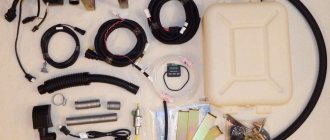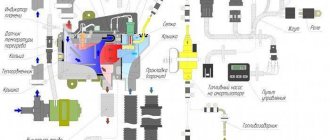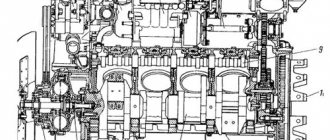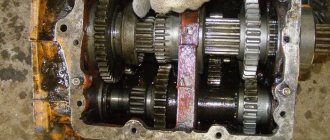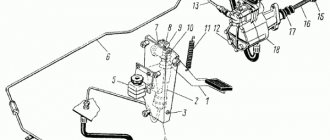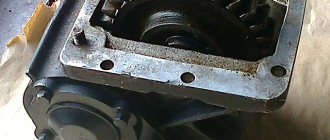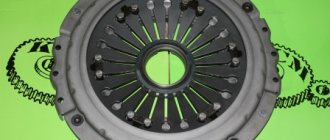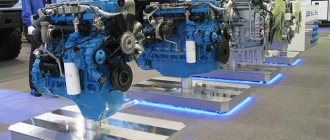Rice. 2.7 Preheater PZD-32
1 - fuel pump; 2 - electric motor; 3 — air blower; 4 - water pump; 5 - suction pipe; 6 — exhaust pipe; 7 - drainage tube; 8 - candle; 9 — fuel pipe; 10 - solenoid valve; 11 — fuel injection line; 12 — nozzle; 13 — swirler; 14-inner burner cylinder; 15 — outer cylinder of the burner; 16 — hot liquid outlet pipe; 17 - combustion chamber; 18 — outer water jacket; 19 — internal water jacket; 20 - gas duct; 21 - water supply pipe to the boiler I - liquid supply; II - injection of liquid into the boiler; III - exhaust gases; IV - liquid supply from the pumping unit: V - air injection into the boiler
Starting procedure for train 30
Starting the engine using the PZD 30 heater must be done in the following order:
If the start of the PZD 30 heater , you need to move the switch to position 0 and after 1 minute. repeat start. If after two attempts with switching to position I for 30 s with intervals between attempts of 1 min. If the heater does not start working, then you need to find the problem and fix it.
When the liquid in the engine cooling system warms up to 70-80°C, it is necessary to stop the fuel supply by setting the switch to position III. Then, after 15-20 seconds (after the flame noise in the boiler has completely stopped), you need to move the switch to position 0 and close the valve of the heater fuel tank. After this, you need to start the engine by pressing the clutch pedal all the way.
Starting the engine using PZD-30 when filling the cooling system with water:
If the heater starts unsuccessfully or stops spontaneously, the start must be repeated, and if it fails, immediately drain the water from the system.
When the engine warms up to the temperature corresponding to the opening temperature of the thermostat valves (which will be indicated by the appearance of steam from the filler neck of the expansion tank), you need to fill the cooling system to its full volume (until water flows through the control valve) through the neck of the expansion tank, then close the neck with a plug .
After filling the cooling system with water, you should lower the cabin and let the heater run until the engine warms up, and then turn off the heater and close the valve of the heater fuel tank and start the engine.
When the engine is running at an average crankshaft speed, open the cabin heater tap and, after filling the heating system with hot water, add water to the expansion tank to 2/3 of its volume.
Technical characteristics of the heater PZD 30
| Type | PZD-30 |
| Heating capacity, kJ/h (kcal/h) | 108857(26000) |
| Fuel | used for engine |
| Fuel consumption, kg/h | 4,5 |
| Fuel ignition | electric spark plug from a transistor switch with a TK107 ignition coil |
| Candle operating time, s | 30 |
| Fuel pre-heater | 200W pin electric candle |
| High voltage spark plug | CH-423, electric spark |
| High voltage switch | TK 107, transistor |
| Solenoid valve | MKT-4 |
| Heater motor | ME 252, power 180 W |
| Motor circuit contactor | KT 127 |
| Fuel heater relay | 11.3704.000 |
| Operating mode switch | VK354 |
| Fuse | one for 30 A, thermobimetallic PRZ. Protects the power supply circuits of the electrical equipment of the preheater |
Possible malfunctions of the PZD-30 preheater, causes and methods for eliminating them
Table 19. Possible malfunctions of the PZD-30 preheater, causes and methods for eliminating them
Source
Pump heater unit: the “heart” and “lungs” of a diesel preheater
Despite the abundance of foreign pre-heaters, many domestic trucks still use PZD heaters. An important part of these devices are pumping units - read the article about their design and operation, features of maintenance and repair.
Purpose of the preheater pump unit
Trucks, tractors and special equipment in Russia are mostly equipped with pre-start heaters - this is a necessary condition for the successful start of a diesel engine in the cold season, extending its service life and reducing repair costs. And despite the fact that today the market offers a huge number of foreign heaters of well-known brands, domestically produced heaters do not lose their relevance. And in the last two or three years, due to a sharp rise in prices for foreign products, Russian heaters have become even more in demand.
Since the 80s of the last century, heaters of the PZhD series (liquid heater, diesel powered) of three series have become most widespread:
— PZD-30 — used on KAMAZ vehicles; — PZD-44 — used on MAZ, KrAZ and some others vehicles;
— PZD-70 — installed on powerful BelAZ dump trucks.
These heaters have a similar technical design and are equipped with the same units. The pumping units of these heaters are the most standardized. These units contain all the pumps and blowers necessary for the operation of the heater, and perform three functions:
— Supply of diesel fuel to the burner (to the nozzle) of the heater; — Coolant circulation in the heater circuit;
— Injecting air into the heater burner.
The pump unit fully ensures the functioning of the preheater. The versatility of the unit is ensured by its design features, which should be considered in more detail.
9. Typical malfunctions when filling the engine cooling system with water.
| Malfunction | Cause |
malfunctions
Troubleshooting method9.1. The electric motor does not work. When turned on, the fuse is triggered. 9.1.1. Freezing of the water pump impeller due to incomplete drainage of water. Warm up the liquid pump housing with available means (torch, blowtorch), periodically checking whether the electric motor can be turned on. 9.2. There is no liquid circulation in the system, the boiler overheats and periodically there is a reverse release of water and steam through the heater fill funnel. 9.2.1. Ice plugs have formed in the pipes and hoses for supplying and discharging liquid due to incomplete drainage of water or improper use of the heater. Warm the pipes by periodically turning the heater on and off (for 2...3 minutes), use available means (a torch, a blowtorch) to warm the pipes. 9.3. The heater has overheated.9.3.1. Formation of an ice plug in the liquid supply pipe from the engine to the heater. Stop the heater, open the drain valve in the boiler. Using improvised means, heat the water supply pipe from the boiler tap, close the tap and turn on the heater.Why doesn't it start
If the preheater does not work, the reason for this may be the following:
- The electric motor of the pumping mechanism does not start.
- The fuel liquid in the PZD boiler does not ignite.
- The fuse was turned off.
- Electric motor relay failure or switch failure.
- An open circuit that connects the wires between the relay and the electric motor.
- Malfunction of the engine itself.
- There is no spark between the spark plug electrodes.
- The overheating and temperature sensors failed.
- Disconnected or reduced voltage in the system.
- The spark plugs have failed.
- The blower motor was damaged.
- There is no communication between control systems.
- The number of engine starts has been exhausted.
- Overheating of heat exchange equipment.
- The flame indicator has failed.
- The supply pipe was damaged.
10.Maintenance.
10.1. Maintenance of the heater must be carried out before the start of the cold season (off-season maintenance). When servicing the heater, the technical condition is checked in accordance with Section 7 of these instructions and, in addition, additional checks are carried out.
10.1.1. Check and, if necessary, clean the internal surfaces of the burner from carbon deposits and soot.
10.1.2. Checking the fuel system and, if necessary, washing and replacing filters, disassembling, washing and assembling the injector.
10.1.3. Check the ignition system and, if necessary, clean the spark plug.
10.1.4 Check and, if necessary, replace the oil seals of the fuel pump and pump unit.
10.1.5 Checking the operation of the heater and adjusting the nominal fuel consumption.
10.2. To check the condition of the burner, disconnect the fuel supply tube from the burner, disconnect the valve with nozzle and electric valve from the burner. heater, unscrew the burner mounting bolts and disconnect the air supply hose, remove the high-voltage drive from the spark plug, remove the burner from the boiler. In a warm room, unscrew the electric spark plug, inspect the internal surface of the burner, if there is carbon deposits inside the burner, use a hard object (screwdriver) and a wire brush to clean the carbon deposits, blow with compressed air and rinse in diesel fuel. Replace the candle.
10.3. In a warm room, disassemble the valve assemblies with a nozzle and an electric heater: unscrew the nozzle, unscrew the filter housing, rinse in acetone and blow out the filter with compressed air (or replace it with a power supply), unscrew the electric heaters, if there is coke on the surface of the electric heater, clean the surface with sandpaper, rinse in diesel fuel and blow with compressed air, wash the internal cavities of the valve body with acetone and blow with compressed air, reinstall the filter and electric heater.
10.4. Disassemble the nozzle and immerse the parts in acetone or unleaded gasoline, carefully rinse the parts, blow the parts with compressed air, and assemble the nozzle.
REMEMBER
that the reliability of the heater’s operation largely depends on the cleanliness of the flushing and the careful assembly of the nozzle.
10.5. Inspect the spark plug, if there is carbon deposits, clean the surface of the insulator from carbon deposits using a rag soaked in gasoline or 00 sandpaper, rinse in diesel fuel and blow with compressed air.
10.6. Check the oil seal of the fuel pump and the pump unit on the car. If the fuel pump seal is damaged, fuel leaks from the drain hole during operation of the pump unit. To check the oil seal of the pump unit, remove the air exhaust hose from the pump unit and turn on the electric motor in the purge mode; if the oil seal is damaged, drops of liquid will fly from the air outlet pipe. If the seals of the fuel pump or pump unit are damaged, remove the pump unit from the car and disassemble and replace the seals in a warm room.
10.7. After servicing the heater components in accordance with paragraphs. 10.2. 10.6 Adjust fuel consumption and check the operation of the heater.
10.7.1 Adjust fuel consumption with the heater running. Fuel consumption should be adjusted at a fuel temperature of +205°C using a pressure reducing valve of the fuel pump. To adjust the flow, turn on the motor and solenoid valve.
After the heater reaches a stable operating mode, adjust the pressure reducing valve so that no flames fly out of the exhaust pipe, i.e. to the flame emission limit.
10.7.2. The operation of the heater is checked on the machine in the following sequence: ignition of the heater and operation for 5...10 minutes in accordance with section 5 of these instructions.
Source
Error codes
Error codes PJ 14TS:
- If the LED blinks once, then the breakdown may be due to overheating of the heat exchanger or the temperature difference reported by the overheating and temperature sensors.
- If the LED element flashes 2 times, the error may be caused by the exhausted number of engine starts.
- The LED flashing three times is a preheater malfunction due to flame interruption.
- When the LED flashes 4 times, the problem may be a faulty spark plug or blower motor.
- 5 times means the flame indicator is broken.
- 6 times are errors in the operation of the overheating and temperature sensors.
- When the LED flashes 7 times, it is recommended to check the integrity of the circulation pump, fuel cell, control relay and heater.
- If the LED flashes 8 times, it means that the connection between the control panel and the control unit has been lost.
- 9 times - the voltage was turned off or reduced.
- 10 times - exceeding the time allotted for ventilation.
Errors and their elimination
When the Teplostar does not start or some part in it has failed, the first thing you need to do is inspect the connectors and contacts. Their characteristics are presented in the table:
Many faults are displayed as error codes.
Each of them has its own decoding. Thanks to such signals, you can fix the problem yourself. Error codes PZD 14TS-10 and their interpretation by the number of blinks from 1 to 10:
- Overheating has occurred in the heat exchanger. The system, using a semiconductor temperature and overheating sensor (SSD), shows +120°C. In this case, it is worth checking the operation of the pump and the functionality of the fluid circuit. If the difference is more than 20°, then change the sensor if necessary.
- All attempts to start have been exhausted, but the boiler does not want to start. In this case, you need to check how much fuel is in the system and how it is supplied. You also need to check the system in which the fuel burns and the pipeline that discharges exhaust gases.
- Flame interruption. The error indicates that you need to check the presence of fuel and its supply system. It is also worth inspecting the air supply system for fuel combustion. When the heating system turns on, you need to check the operation of the flame indicator and, if necessary, replace it. The filter installed on the fuel may be clogged.
- This error code 14TC-10 indicates that there are problems with the glow plug. Perhaps a fault in the motor is to blame. The supercharger wiring and spark plug operation should be checked. If necessary, components must be replaced.
- Flame indicator problem. The wiring needs to be inspected. It is worth checking the resistance of the indicator contacts: if the reading is more than 90 Ohms, an open is detected, less than 10 Ohms - a short circuit.
- The temperature and/or overheating sensor has become unusable. It's worth checking the wires. Most likely, you will have to replace the sensors.
- Failures in the circulation pump. If there is a break in the electrical circuits, then they need to be replaced. The short circuit must be repaired. If there are problems with the relay, it should be replaced with a new one.
- There is no connection between the remote control and the control unit. You need to carefully inspect the connectors and wiring.
- High/low voltage, the device has switched off. The battery, wiring, or voltage regulator must be repaired.
- The time allotted for ventilation has expired. The battery has not completely cooled down over a certain period of time. It is necessary to recheck the system supplying air to the fuel combustion chamber, and also replace the flame indicator.
Opinions about Teplostar are mostly positive. If you want to purchase it, then you should read the reviews and make sure that it is really necessary. The model range consists of the 11TS heater and 16 modifications of the 14TS. The manufacturer provides a guarantee for each device, but if instructions for proper operation are ignored, claims regarding malfunctions will not be considered.
